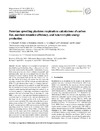Please use this identifier to cite or link to this item:
https://accedacris.ulpgc.es/handle/10553/45661
| Title: | Peruvian upwelling plankton respiration: calculations of carbon flux, nutrient retention efficiency, and heterotrophic energy production | Authors: | Packard, T. T. Osma, N. Fernández-Urruzola, I. Codispoti, L. A. Christensen, J. P. Gómez, M. |
UNESCO Clasification: | 251001 Oceanografía biológica | Keywords: | Plankton respiration | Issue Date: | 2015 | Journal: | Biogeosciences | Abstract: | Oceanic depth profiles of plankton respiration are described by a power function, RCO2 = (RCO2)0 (z/z0)b, similar to the vertical carbon flux profile. Furthermore, because both ocean processes are closely related, conceptually and mathematically, each can be calculated from the other. The exponent b, always negative, defines the maximum curvature of the respiration–depth profile and controls the carbon flux. When |b| is large, the carbon flux (FC) from the epipelagic ocean is low and the nutrient retention efficiency (NRE) is high, allowing these waters to maintain high productivity. The opposite occurs when |b| is small. This means that the attenuation of respiration in ocean water columns is critical in understanding and predicting both vertical FC as well as the capacity of epipelagic ecosystems to retain their nutrients. The ratio of seawater RCO2 to incoming FC is the NRE, a new metric that represents nutrient regeneration in a seawater layer in reference to the nutrients introduced into that layer via FC. A depth profile of FC is the integral of water column respiration. This relationship facilitates calculating ocean sections of FC from water column respiration. In an FC section and in a NRE section across the Peruvian upwelling system we found an FC maximum and a NRE minimum extending down to 400 m, 50 km off the Peruvian coast over the upper part of the continental slope. Finally, considering the coupling between respiratory electron transport system activity and heterotrophic oxidative phosphorylation promoted the calculation of an ocean section of heterotrophic energy production (HEP). It ranged from 250 to 500 J d−1 m−3 in the euphotic zone to less than 5 J d−1 m−3 below 200 m on this ocean section. | URI: | https://accedacris.ulpgc.es/handle/10553/45661 | ISSN: | 1726-4170 | DOI: | 10.5194/bg-12-2641-2015 | Source: | Biogeosciences [ISSN 1726-4170], v. 12, p. 2641-2654 |
| Appears in Collections: | Artículos |
SCOPUSTM
Citations
16
checked on Jun 1, 2025
WEB OF SCIENCETM
Citations
14
checked on Jun 1, 2025
Page view(s)
106
checked on Jul 27, 2024
Download(s)
122
checked on Jul 27, 2024
Google ScholarTM
Check
Altmetric
Share
Export metadata
Items in accedaCRIS are protected by copyright, with all rights reserved, unless otherwise indicated.
